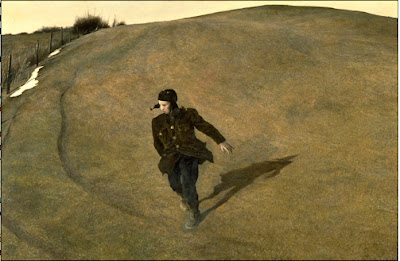Andrew Wyeth's Studio
Saturday morning my wife Alice and I drove up to Wilmington, Delaware to visit the Delaware Art Museum (which has a great Permanent Collection and an equally impressive climate control system). Later on we headed over to the heart of Wyeth country, nearby Chadds Ford, PA. Sunday we visited the Brandywine River Museum, which is always a treat, and were delighted to find the Museum had just opened up tours of Andrew Wyeth's studio to the public. Wyeth (1917 -2009) isn't an artist who was a direct influence on me as a painter, but he's someone I've always greatly respected. So we hopped on the Museum's tour bus and headed off.
I know many people in the art world who have mixed feelings about the Wyeths. Some find Andrew's work sentimental and retrograde. It's true his painter's imagination found its deepest reverie in images that could have happened in 1850. To me though his sharp eye and his ability to design amazingly tantalizing compositions is hard to beat.
Maybe a lot of the resistance in the more "sophisticated" art world is tainted by the legions of Andrew Wyeth imitators who have been churning out some pretty uninspired Wyeth-like imagery, but without his powerful inventiveness with shapes and color. I think we've all seen one too many paintings of barns with weathered planking that lack any real teeth. Above is one of his most famous paintings, Winter, 1946. I'll return to it at the end of this post.
Wyeth's studio is just a short distance from the Brandywine River Museum. It's an unassuming little building, a former school house, and I can't recall when they said it was built (It was so hot on the tour that my brain was only half functioning and I missed some of the information the tour guide was telling us). But like any Wyeth painting, it was old.
Here's a clue to one reason Andrew Wyeth was such a good painter- the sign outside his studio doorway.

It takes a long time to get a painting just right. Wyeth knew that and valued his time.
Here's Alice suffering away with the other tour members waiting to be let into the at least relatively cooler studio.
Below is a photo of the roof just above the doorway. We all pretended to be waiting patiently for it to open but inwardly I suspect we were getting desperate to get out of the heat.
Unfortunately photography isn't allowed in the studio which is sad. The interior was fascinating and revealing.
While inside there were two rooms that had been used as studios, neither was all that large, and the one Andrew had usually worked in was actually surprisingly modest. (Remember Wyeth was born to some means, and his early career success would have allowed him to purchase a domed stadium for a studio had he wanted that). Instead he opted for privacy and quiet. The one luxury was a large north facing window he had built to illuminate the smaller studio room. Still, it was cramped.
In contrast, the studio of Wyeth's father, N. C. Wyeth, the famously successful illustrator and painter, was just up the hill. We had toured it two years ago and it couldn't have been more different. It sits on a majestic high point, grandly mastering the landscape below. Andrew's studio occupies an unassuming spot at the bottom of a hill. Where Andrew's work space was about quiet and intimacy, N.C.'s was grand- two huge rooms where you could fit a hundred people.

Here's a drawing a teenage Andrew Wyeth made of his father working in the studio.

The two artists' preferences for studios reflects the different temperament between the father's and the son's painting. Here's a great painting by N.C. illustrating two men fighting in the surf. His story telling is bold and overt. Compare that to the Andrew Wyeth below of the boy running down the hill- perhaps the most action filled of any of Andrew's paintings. Where N.C. leaves nothing to chance, Andrew gives you more a mystery to solve.


That said, I think they're both terrific paintings.
N.C. was Andrew's teacher and he taught his son well. Look at the silhouettes of the figures. Andrew's running boy at the bottom with his outstretched arm seems indebted to the rock wielding combatant in the surf above. Andrew Wyeth of course is known for his skillfully applied layers of details. What this juxtaposition of paintings helps reveal is how he based his paintings on a framework of bold simple shapes that he learned from his father.
In my own work over the years I've moved from the painstakingly detailed paint application of my graduate school days to a much more broad handling, especially in my paintings of the last 15 years. This has been less a conscious decision than an evolution. I kept finding my paintings became richer and more evocative when I pared them down to focus on fewer key ideas. The essence of the painting has to be in the overall action of the composition. Often I'll tell my students if you get the painting to come to life before you've added any detail then you've got a real shot at pulling the thing off beautifully.
A good example of this boiling things down to their essential forms is my painting The Song of All Days, oil on panel, 36 x 72", 2008 below.
It will be on display in the Delaware Art Museum's Centennial Juried Exhibition this October 20 through January 13, 2013. In conjunction with the painting appearing in the exhibition, Delaware Art Museum is going to have me teach a half day landscape painting workshop on Sunday, Oct. 21 at the Museum (details TBA).
Reminder:
My old website philipkoch.com has been replaced by a new site philipkoch.org
Its content is being regularly augmented over the next couple of weeks.





